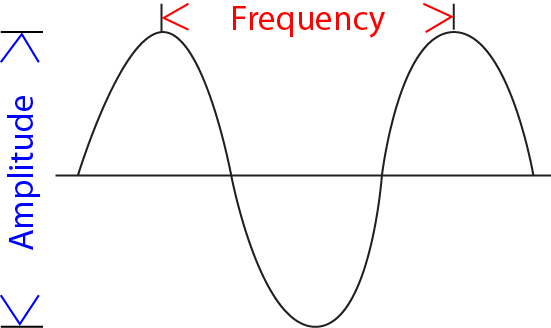You’ve mastered some great challenges in this module.
Great job! Now for a new kind of adventure, the next stop is a Coding challenge. Learn how to take control through programming. Good luck!
Experiment |
Are We on the Same Wavelength?
Grades:
Time:
Subject:
5-8
20-30 minutes
Physics
Wavelength, frequency, and amplitude are all close friends in the world of sound. Let’s get to know them better!
When you look at a representation of a simple sound wave (let’s say the note “C”) on an oscilloscope or another visualization tool, you will see a squiggly line going up and down in a regular pattern. This pattern, the sound wave, contains three attributes: wavelength, frequency, and amplitude.
 Put simply, the amplitude is the height of the wave from its highest point to its lowest, frequency is how many complete wave cycles occur per second, and the wavelength is the distance between waves which you can measure from wave crest to wave crest. Wavelength and frequency are tied very closely together since sound waves travel at a particular speed through a medium.
Put simply, the amplitude is the height of the wave from its highest point to its lowest, frequency is how many complete wave cycles occur per second, and the wavelength is the distance between waves which you can measure from wave crest to wave crest. Wavelength and frequency are tied very closely together since sound waves travel at a particular speed through a medium.
The shorter the wavelength then, the higher the frequency!
Some important background for this activity:



Understand:
Microphone: A microphone, sometimes referred to as a mike or mic (both IPA pronunciation: [maɪk]), converts sound into an electrical signal.
Sound Wave: Sound is a vibration that travels in waves through a medium, such as air (or water, wood, etc.), a disturbance which travels through some medium.
Vibration: Vibration is an oscillating (back and forth) movement, like a vibrating reed in a clarinet. This vibration results in a sound wave that then travels through a medium, like the air.
Pitch: Pitch is the highness or lowness of sound. Pitch is how humans hear different frequencies
Frequency: Frequency is determined by the number of vibrations per second. The highest key on a piano, for instance, vibrates 4,000 times per second.
Amplitude: The amplitude or peak amplitude of a wave is a measure of how big its oscillation is.
Decibel: (db):Sound intensity is measured in units called decibels. A decibel (or dB) measures ratios of power or intensity. It expresses them as an exponential function.
Medium: In physics, a transmission medium is the substance that transmits the energy from a wave. The standard transmission medium for sound that we know well is air. Water, wood, clay – which of these have you heard sounds penetrate? If sound can be transmitted, it’s a medium.
Arduino IDE
Google Science Journal
Sound waves have three major attributes, frequency, amplitude, and wavelength. By experimenting with pitch and intensity, you have experienced frequency and amplitude. Wavelength we can’t see directly, but you can calculate it from the data you know. Let’s check out wavelength!
Look at the Wave Equation again below.

It is important to know that sound travels at different speeds through different mediums. If you are hearing sound underwater, for example, it is traveling much faster than if you hear it when it travels through the air. This is because sound is a vibration that requires “something” to vibrate in order for it to travel. The speed of sound in air, based on the sound wave transferring vibrations through air molecules, is 767 miles per hour or 343 meters per second (343 m/s). Note this actually changes based on temperature – this speed is assuming normal room temperature of 20 degrees C.
Since we know two parts of our Wave Equation, frequency (f), and the speed of sound through air is V, the speed of the wave at 343 m/s, we can calculate the wavelength of a sound!
Were your guesses close? Are you surprised at the wavelength calculation or was it about what you expected? What do you think is the wavelength of a sound like a loud, throaty motorcycle? How about a chirping bird?
If you have some time left do some further experimentation with databot™ do some exploring. What experiments can you conduct to learn more about sound? Do different objects have different frequencies when they are dropped? Different intensities if dropped from the same height? Get creative and learn more about the sound you can’t see!
Great job! Now for a new kind of adventure, the next stop is a Coding challenge. Learn how to take control through programming. Good luck!
Educator Info
Understand:
CDC: What Noises Cause Hearing Loss?
https://www.cdc.gov/nceh/hearing_loss/what_noises_cause_hearing_loss.html
NASA – The Sounds of Space
https://www.nasa.gov/vision/universe/features/halloween_sounds.html
Misconceptions about sound
http://amasci.com/miscon/opphys.html
Explain that Stuff – Sound
https://www.explainthatstuff.com/sound.html
Temperature and the Speed of Sound
https://www.nde-ed.org/EducationResources/HighSchool/Sound/tempandspeed.htm
Online Tone Generator (useful for making pure frequency sounds)
https://www.szynalski.com/tone-generator/
Virtual Oscilloscope
Wavelength Image – Wikimedia Commons
https://commons.wikimedia.org/wiki/File:Tour-of-the-EMS-TAGGED-v7_0.pdf
Frequency and Amplitude Image – Wikimedia Commons
https://commons.wikimedia.org/wiki/File:SoundWaveDiagFreqAmp.png
Sound Barrier Image – Wikimedia Commons: By Ensign John Gay, U.S. Navy – This Image was released by the United States Navy with the ID 990707-N-6483G-001. Public Domain, https://commons.wikimedia.org/w/index.php?curid=11927
 Can You See the Music? by Robert O. Grover & Team databot™ is licensed under a Creative Commons Attribution 4.0 International License. Permissions beyond the scope of this license may be available at databot.us.com/contact.
Can You See the Music? by Robert O. Grover & Team databot™ is licensed under a Creative Commons Attribution 4.0 International License. Permissions beyond the scope of this license may be available at databot.us.com/contact.
![]()